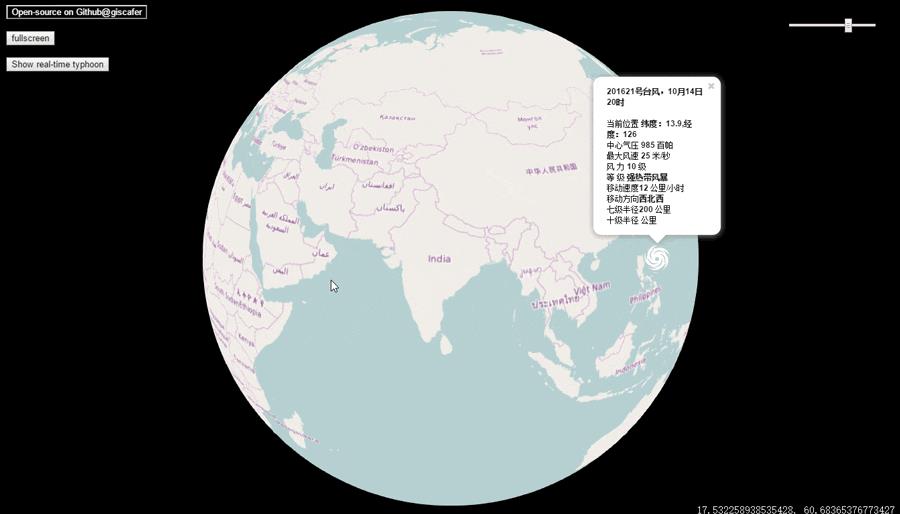WebGL Earth台风监测web应用实战讲解
Posted giscafer
tags:
篇首语:本文由小常识网(cha138.com)小编为大家整理,主要介绍了WebGL Earth台风监测web应用实战讲解相关的知识,希望对你有一定的参考价值。
前言
花了一天时间,开发了一个基于WebGL Earth的台风监测系统,写这个web应用的目的有两个:
1、我在github上创建了@viseye组织已经一段时间,但是迟迟没有项目,于是近期打算写一个
2、另一个原因是我再知乎开了可视化编程专栏,文章偶尔需要继续更新,就得找些东西来写
Github @viseye:https://github.com/viseye
知乎可视化编程专栏:https://zhuanlan.zhihu.com/viseye
VisEye Website: http://viseye.xyz
台风监测web应用webglearth-typhoon
运行截图

Demo Url
在线demo:http://viseye.xyz/webglearth-typhoon/
建议使用支持WebGL HTML5的浏览器打开,IE10+或新版Google Chrome等
iPhone 浏览器和微信(ios)内置浏览器测试可打开
实现
1、服务端
服务端使用nodejs搭建服务器,提供前端数据请求的api接口,目前部署于BAE
app.js代码如下,主要是使用express搭建一个简单的server
/**
* app entry
*/
'use strict'
const path=require('path');
const express=require('express');
const bodyParser=require('body-parser');
const Typhoon=require('node-typhoon');
const app=express();
app.set('port',(process.env.PORT || 3000));
app.use('',express.static(path.join(__dirname,'public')));
app.use(bodyParser.json());
app.use(bodyParser.urlencoded({extended:true}));
// Additional middleware which will set headers that we need on each request.
app.use((req, res, next)=>{
res.setHeader('Access-Control-Allow-Origin', '*');
// Disable caching so we'll always get the latest comments.
res.setHeader('Cache-Control', 'no-cache');
next();
});
//get real-time typhoon information
app.get('/api/typhoonActivity',(req,res)=>{
Typhoon.typhoonActivity().then(info=>{
res.send(info);
}).catch(err=>{
res.send(err);
});
});
//get historical typhoon information
app.get('/api/typhoonList',(req,res)=>{
let year=new Date().getFullYear();
Typhoon.typhoonList(year).then(info=>{
res.send(info);
}).catch(err=>{
res.send(err);
});
});
app.listen(app.get('port'),()=>{
console.log('Server started: http://localhost:'+app.get('port')+'/');
});2、中间件 node-typhoon
中间件说的是nodejs的middlemodule,webglearth-typhoon使用了个人自己封装的node-typhoon(已发布到npm),提供了获取实时台风的接口,以及历史台风信息的接口,目前版本是v1.0.0,后期会更新。
如下数据结果是今天(2016年10月15日11:53:33)获取的台风信息,两个台风从太平洋方向过来
[
{
"enname": "SARIKA",
"lat": "14.40",
"lng": "124.30",
"movedirection": "西北西",
"movespeed": "22",
"name": "莎莉嘉",
"power": "12",
"pressure": "970",
"radius10": "100",
"radius7": "220",
"speed": "35",
"strong": "台风",
"tfid": "201621",
"time": "2016-10-15 11:00:00",
"timeformate": "10月15日11时"
},
{
"enname": "HAIMA",
"lat": "8.20",
"lng": "143.90",
"movedirection": "北西",
"movespeed": "22",
"name": "海马",
"power": "8",
"pressure": "998",
"radius10": null,
"radius7": "200",
"speed": "18",
"strong": "热带风暴",
"tfid": "201622",
"time": "2016-10-15 08:00:00",
"timeformate": "10月15日8时"
}
]更多见:https://www.npmjs.com/package/node-typhoon
3、前端 webglearth2
官方介绍:
webglearth2 - WebGL Earth 2 - the source code of the project,There is an extremely easy to use javascript API - fully mimicking LeafletJS.
webglearth2是一个开源虚拟地球web应用程序,可以运行在任何支持html5 WebGL标准的web浏览器上,以及移动设备,如iPhone,iPad或基于android的手机也会支持。此外提供LeafletJS封装的地图API。
传送门:https://github.com/webglearth/webglearth2
webglearth-typhoon实现整个思路:
前端加载虚拟三维球+地图后,通过调用nodejs服务器中node-typhoon提供的Api获取台风信息,数据返回前端后,组装好,通过marker和气泡弹窗展示信息的方式加载到地图。This is all~
TODO
1、加上历史台风查询展示;
2、实时台风路径情况
(感兴趣的同学可以一起开发)
总结
总结一下用到的技术
JavaScript+HTML5+CSS 网页必须的,不多说
JavaScript新标准ES6,源码可能用了一些ES6的新特性书写
WebGL
LeafletJS 一个地图JavaScript库
Nodejs 服务端
好像都是JavaScript~~~
源码
Github:https://github.com/viseye/webglearth-typhoon
以上是关于WebGL Earth台风监测web应用实战讲解的主要内容,如果未能解决你的问题,请参考以下文章
Web 3D智慧变电站三维工程进度系统-WebGL/Threejs实战开发
python安装sklearn-contrib-py-earth包实战:pip和conda安装失败手动下载whl文件安装实战